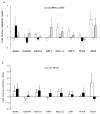Impact of hot and cold exposure on human skeletal muscle gene expression
- PMID: 28177744
- PMCID: PMC5325790
- DOI: 10.1139/apnm-2016-0415
Impact of hot and cold exposure on human skeletal muscle gene expression
Abstract
Many human diseases lead to a loss of skeletal muscle metabolic function and mass. Local and environmental temperature can modulate the exercise-stimulated response of several genes involved in mitochondrial biogenesis and skeletal muscle function in a human model. However, the impact of environmental temperature, independent of exercise, has not been addressed in a human model. Thus, the purpose of this study was to compare the effects of exposure to hot, cold, and room temperature conditions on skeletal muscle gene expression related to mitochondrial biogenesis and muscle mass. Recreationally trained male subjects (n = 12) had muscle biopsies taken from the vastus lateralis before and after 3 h of exposure to hot (33 °C), cold (7 °C), or room temperature (20 °C) conditions. Temperature had no effect on most of the genes related to mitochondrial biogenesis, myogenesis, or proteolysis (p > 0.05). Core temperature was significantly higher in hot and cold environments compared with room temperature (37.2 ± 0.1 °C, p = 0.001; 37.1 ± 0.1 °C, p = 0.013; 36.9 ± 0.1 °C, respectively). Whole-body oxygen consumption was also significantly higher in hot and cold compared with room temperature (0.38 ± 0.01 L·min-1, p < 0.001; 0.52 ± 0.03 L·min-1, p < 0.001; 0.35 ± 0.01 L·min-1, respectively). In conclusion, these data show that acute temperature exposure alone does not elicit significant changes in skeletal muscle gene expression. When considered in conjunction with previous research, exercise appears to be a necessary component to observe gene expression alterations between different environmental temperatures in humans.
Keywords: ARNm; biogenèse mitochondriale; mRNA; mitochondrial biogenesis; myogenesis; myogenèse; proteolysis; protéolyse; temperature; température.
Conflict of interest statement
DISCLOSURE OF POTENTIAL CONFLICTS OF INTEREST
The authors report no potential conflicts of interest associated with this manuscript.
Figures




Similar articles
-
Effects of exercise in a cold environment on transcriptional control of PGC-1α.Am J Physiol Regul Integr Comp Physiol. 2018 Jun 1;314(6):R850-R857. doi: 10.1152/ajpregu.00425.2017. Epub 2018 Mar 14. Am J Physiol Regul Integr Comp Physiol. 2018. PMID: 29537859 Free PMC article.
-
Human mRNA response to exercise and temperature.Int J Sports Med. 2012 Feb;33(2):94-100. doi: 10.1055/s-0031-1287799. Epub 2011 Nov 23. Int J Sports Med. 2012. PMID: 22113536 Clinical Trial.
-
Impact of local heating and cooling on skeletal muscle transcriptional response related to myogenesis and proteolysis.Eur J Appl Physiol. 2018 Jan;118(1):101-109. doi: 10.1007/s00421-017-3749-z. Epub 2017 Oct 28. Eur J Appl Physiol. 2018. PMID: 29080996
-
Hot and cold as an explanatory model: the example of Bharuch district in Gujarat, India.Soc Sci Med. 1987;25(4):389-99. doi: 10.1016/0277-9536(87)90277-2. Soc Sci Med. 1987. PMID: 3317876 Review.
-
Responses of the microcirculation to hot and cold environments.Pharmacol Ther. 1988;38(2):201-14. doi: 10.1016/0163-7258(88)90097-6. Pharmacol Ther. 1988. PMID: 3054939 Review. No abstract available.
Cited by
-
Extreme Terrestrial Environments: Life in Thermal Stress and Hypoxia. A Narrative Review.Front Physiol. 2018 May 16;9:572. doi: 10.3389/fphys.2018.00572. eCollection 2018. Front Physiol. 2018. PMID: 29867589 Free PMC article. Review.
-
The independent effects of local heat application on muscle growth program associated mRNA and protein phosphorylation.J Therm Biol. 2023 Jul;115:103602. doi: 10.1016/j.jtherbio.2023.103602. Epub 2023 Jun 10. J Therm Biol. 2023. PMID: 37331320 Free PMC article.
-
Effects of exercise in a cold environment on gene expression for mitochondrial biogenesis and mitophagy.Cryobiology. 2019 Oct;90:47-53. doi: 10.1016/j.cryobiol.2019.08.007. Epub 2019 Aug 27. Cryobiology. 2019. PMID: 31469981 Free PMC article.
-
The isolated effects of local cold application on proteolytic and myogenic signaling.Cryobiology. 2023 Sep;112:104553. doi: 10.1016/j.cryobiol.2023.104553. Epub 2023 Jun 26. Cryobiology. 2023. PMID: 37380094 Free PMC article.
-
Effect of heat acclimation on metabolic adaptations induced by endurance training in soleus rat muscle.Physiol Rep. 2021 Aug;9(16):e14686. doi: 10.14814/phy2.14686. Physiol Rep. 2021. PMID: 34405575 Free PMC article.
References
-
- Braun T, Rudnicki MA, Arnold H, Jaenisch R. Targeted inactivation of the muscle regulatory gene Myf-5 results in abnormal rib development and perinatal death. Cell. 1992;71(3):369–382. - PubMed
-
- Engels H, Yarandi HN, Davis JE. Utility of an ingestible capsule for core temperature measurements during body warming. J Ex Phys. 2009;12:1–9.
-
- Fosslien E. Mitochondrial medicine-molecular pathology of defective oxidative phosphorylation. Ann Clin Lab Sci. 2001;31(1):25–67. - PubMed
Publication types
MeSH terms
Substances
Grants and funding
LinkOut - more resources
Full Text Sources
Other Literature Sources
Miscellaneous

